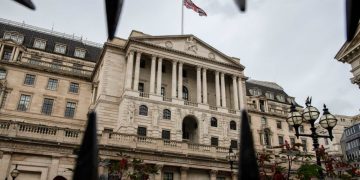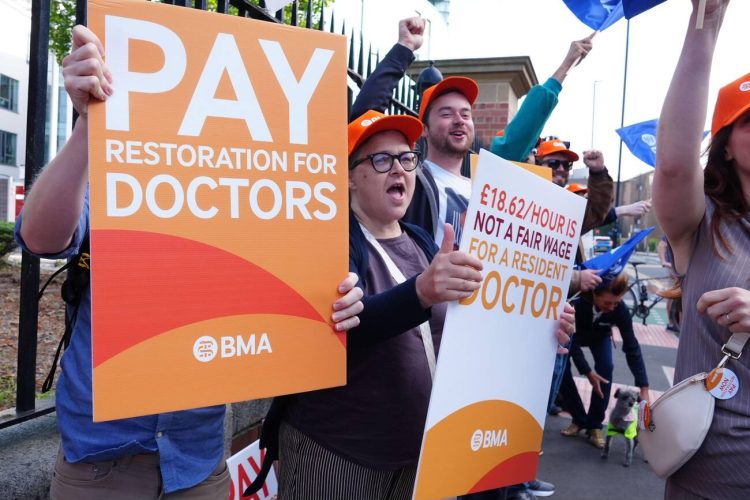The UK doctors ‘ strikes, once again erupting in July 2025, are proof of a deeper institutional breakdown in the NHS. Wage issues only, these strikes are symptomatic of years of chronic underfunding, staff burnout, and mismanagement. Despite all the earlier talks, frontline NHS workers, especially Resident doctors, argue that their salaries haven’t kept pace with inflation or the volume of work. The once-proud NHS is now crisis-ridden, with staff morale at a historic low. This article discusses the ongoing UK doctors’ strikes as a symptom of a more profound structural crisis within the NHS, focusing on pay disputes, staff dissatisfaction, and the broader impact on the healthcare system.
New Strike, Old Demands
Resident doctors in England went on a five-day strike from 25 July 2025, claiming that their pay had decreased by 20–25% in real terms since 2008. Despite a 9% pay rise in 2023, they argue it did not halt long-term depletion. These UK doctors’ strikes are an indication of the breakdown of short-term solutions. The BMA argues nothing short of complete pay restoration will end the current brain drain of healthcare professionals. Negotiations with the government collapsed, and trust between doctors and policymakers has broken down severely.
Continuing Protests Without Progress
Doctors and nurses have staged several strikes over the last three years to no lasting effect. While some received partial rises, none of the pay adjustments addressed the underlying issue of long-term pay stagnation. The public, initially sympathetic, has grown weary of successive disruptions. Healthcare professionals claim these actions are the final measure to demand change, however. These strikes amount to more than individual grievances—they demonstrate institutional rigidity in addressing staff well-being.
Patient Care at Risk
Each new strike wave piles on top of an already stressed system. Postponed diagnostics, cancelled appointments, and delayed surgeries have a ripple effect on patient care. The July UK doctors’ strikes have already disrupted thousands of planned procedures. With COVID-19 backlogs still to clear, patients face longer waiting times and reduced access to essential services. Health administrators warn that prolonged strikes can have a lasting effect on population health and treatment outcomes.
Pay Cut Over the Years
Financial analysis proves that the NHS has failed to keep staff wages in line with inflation or workload. Nurses are now £8,000 worse off than they were in 2010, as are the Resident doctors. The pay cut comes at a time of the ongoing upward trend in the UK cost of living. The BMA’s demand is based on evidence that pay for doctors has fallen even further behind their private-sector counterparts. The medical profession, once seen as being well-paid, is now seen as unsustainable for those entering it.
Broken System, Broken Contracts
The pay issues are just one facet of an underlying structural crisis. In the eyes of many doctors, the 2012 Health and Social Care Act introduced unwelcome bureaucracy, fragmented services, and destabilised career progression paths. The Act shifted responsibility away from the central government to NHS England, making governance and funding streams more complicated. This environment has left many feeling over-regulated and under-supported. The UK doctors’ strikes are an expression of frustration not only with pay but with a broken management culture that is failing to prioritise clinical care.
Temporary Solutions, Permanent Problems
While some governmental proposals have shelved industrial action in the short term, they often fall short of achieving long-term solutions. The recent strikes of 2023 had short-term solutions, only for the same problems to re-emerge in 2024 and again in 2025. Without widespread reforms, the cycle will likely continue. Doctors demand predictable pay scales, modernised contracts, and guarantees on working conditions. These are required if the government is earnest about bringing an end to the era of recurring UK doctors’ strikes.
Eroding Public Support
Public sympathy for NHS workers is not unlimited. A YouGov survey last week found support for the doctors’ strike has dropped below 35%, and over 50% are against any further disruption. Patients who face postponed operations and repeated cancellations feel they are caught in a political and professional crossfire. Some worry that if the trend continues, it will cause permanent damage to trust in the NHS. The healthcare unions argue that short-term pain is necessary for long-term viability.
Government’s Hard Line
The government argues that its current offer—nearly 29% in staged pay increases—is fair within economic constraints. Ministers warn that agreeing to complete pay restoration would set a precedent across public services. Union leaders and doctors, however, maintain that without pay levels restored to pre-2010 levels, the NHS will not be able to recruit and retain key staff. The current impasse contributes to the impression that healthcare professionals and political decision-makers operate on entirely different timelines and priorities.
NHS Spending Gaps Widen
During strikes, NHS spending on short-term solutions is growing. Hospitals are recruiting as high as £8,000 a shift temporary consultants via agencies to make up for the staff shortages caused by the strike. The cost of these temporary staff puts local health budgets under strain and reduces funding for investment in the medium and long term. High-cost temporary staff cannot be maintained, especially when the same amount of money can go into improved pay and conditions for permanent staff. The NHS appears to be in a cycle of crisis management rather than change.
Evidence of Systemic Breakdown
Evidence shows that while strikes do not directly kill patients, they lead to delayed treatment and add extra strain on emergency services. The 2016 junior doctor strike had minimal impact on mortality but significant delays in services. The UK doctors’ strikes now mirror those impacts on a larger scale. The more the crisis drags on, the more it undermines staff morale and service quality. It is no longer an industrial dispute—it’s a sign of system failure.
Only Structural Reform Can End the Cycle of UK Doctors’ Strikes
UK doctors’ strikes are a demonstration of an intensifying crisis that short-term wage hikes and spot deals can no longer solve. Until wholesale structural reform—fair pay, contractual certainty, and a sustainable staffing plan—is on the horizon, the NHS will continue in disarray. A health service cannot work if its staff are demoralised, short-changed, and disregarded. The politicians have to do something soon to save the NHS’s reputation and the health of the country it serves.





























